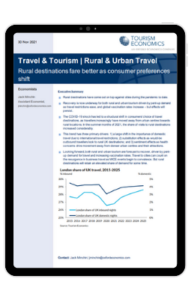Rural travel destinations fare better as consumer preferences shift

The COVID-19 shock has led to a structural shift in consumers’ choice of travel destinations, as travellers increasingly have moved away from urban centres towards rural locations. In the summer months of 2021, the share of visits to rural destinations increased considerably.Access this report to learn about:
- Greater levels of domestic travel have led to increased travel to rural areas. As governments introduced strict international travel restrictions to curb the pandemic, the impact of the collapse in levels of international arrivals fell more heavily on cities, which are more reliant on international visitors.
- Consumer preferences have shifted from urban centres towards rural locations. Consequently, domestic travellers constituted a larger share of total levels, and, with rural travel largely reliant on domestic visitors, rural destinations were more resilient against severe shocks to international arrivals
- Share of domestic visits to rural destinations increased from 51% to 59% between 2019 and 2021. As a result of these processes, we have seen the UK share of domestic visits to rural destinations increase by eight percentage points from 51% in 2019 to 59% in the summer of 2021.
Tags:
Related Services

Post
UK: Supply constraints are probably less prominent in the south
The extent to which UK employers can respond to likely 2024 interest rate cuts with increased output, rather than rises in prices and wages, will partly reflect the extent of spare capacity. This will inevitably vary by region. Evidence on this is imperfect, but in terms of capital assets (including intangibles) and labour availability, southern regions appear to be in a stronger position than those in the UK's traditional industrial heartland.
Find Out More
Post
Global Private equity real estate fund maturities spur asset sales
We expect the significant increases in fund maturities, spurred by capital raised over the past decade, to exert upward pressure on the rate of asset disposals as the funds approach the end of their lifecycles.
Find Out More